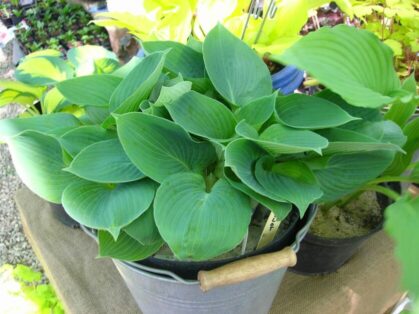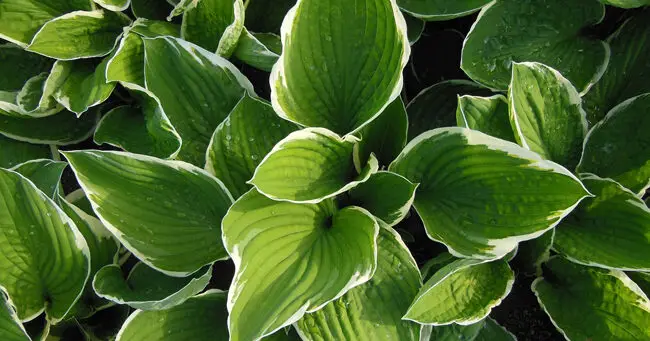Hosta is a very interesting plant in the garden because it appreciates both shady and sunny exposures.
Flowering takes place from June to September, sprout begin around April (depending on the species). There is always a hosta that will go in your garden. It develops a beautiful decorative foliage, matte green, bluish green and even coppery or two-colored, variegated or bordered with white.
It is also a plant which requires only little maintenance, but it has a weak point… Molluscs! They revel in them….
Contents
How to plant hostas?
To make a success of the plantation of your hostas :
- Begin by placing the lump in a basin filled with water to rehydrate it.
- In the meantime, work the soil to loosen it and take advantage of the time to bring in some compost or well-decomposed manure.
- Dig a hole two to three times the volume of the root ball.
- Place the root ball in the planting hole, with the top of the root ball at ground level.
- Fill in all around with soil, then pack lightly.
- Water generously.
It is best to continue watering in the following weeks while the plant settles and develops its root system.
We also advise you to place a mulch around the plant, composed of dead leaves, fragmented rameal wood (BRF), flax or hemp flakes, 5 to 10 centimeters thick.
If you plant in a pot, it is not necessary to work particularly on the drainage. Fill a pot with potting soil, possibly mixed with garden soil, and plant your hosta.
When to plant hostas?
The best planting time is early fall to gain a growing season. It is also possible to plant in the spring.
Rather undemanding, hostas require little care. Once installed, they live a very long time and often spread out by themselves. They prefer fairly fertile, cool but well-drained soils. Incorporate a little potting soil at planting and water regularly, at least during the first year.
Fertilize by spreading garden compost at the base of the plants. Hostas can tolerate dense shade, but prefer mid-shade. They can also be planted in the sun, in temperate regions, as long as the soil is kept cool.
Space the feet 30 to 50 cm apart. Propagation is easy, by dividing the tufts in spring or autumn.
Why plant a hosta
In a deep, cool and well-drained soil, the hosta is at its ease. Some species such as Hosta crispula are perfect on the edge of a body of water. Tolerating half-shade as well as full sun, it is not difficult to satisfy. It is a plant with a long lifespan, which is propagated by runners (like strawberry).
At the time of planting, loosen the soil well and if it is clayey bring a bucket of gravel (Seine sand) that you will mix well with the soil. Make sure to place the collar well above the soil level. Plug the hole and water. Finish by depositing a 2 cm layer of gravel on a surface equivalent to that occupied by the foliage.

Maintenance of the hosta
Fresh soil
As the Hostas all originate from China and Japan, where they grow in humid undergrowth, in the garden or on the rocky banks of rivers, they must be offered the natural freshness they appreciate.
A deep, humus-bearing, slightly peaty or consistent soil, so that it retains moisture well, will be perfect. A supply of well-decomposed organic matter (Brown Gold® type) is ideal. The growth is rather fast, the clump is adult in five years.
Planting distance
From 20 to 60 cm in all directions depending on the species and varieties.
Reasonable sun shade
Contrary to popular belief, they are not just shade plants. They are perfectly successful in the sun, provided that the exposure is not scorching. The variegated varieties express all the subtlety of their foliage only in full light.
The hostas with golden foliage also appreciate a rather bright light and are more beautiful in a sunny situation. But the hostas do not tolerate drought and high temperatures which cause the foliage to dry out quickly.
2 enemies: drought and slugs
This plant does not really pose any problem except the obligation to fight against the slugs which feast on its foliage. Granules containing metaldehyde or mercaptodimethur will ensure an effective protection. A flax flake-based mulch effectively repels these invaders, while ensuring an interesting ground covering.
Since hostas fear drought, it is a good idea to make a mulch every year in the spring with a bed of compost or half decomposed manure. Bark mulch or pine needles will also do the trick (read: Choosing a mulch).
Hosta attacks and diseases
The only serious enemies of hostas are slugs and snails that devour the foliage at all stages of its growth.
To avoid suffering from them, check that neither slugs nor snails are hiding under the edges of the pots. In the ground, make sure to surround the plants with very fine mulch such as crushed fern or flax straw.
How to repel slugs
Is your hosta the main course for slugs? Here are a few rules that will help it stop being their favorite target.
First of all, choose cultivars with leaves that are too tough for these gastropods. These so-called slug-resistant varieties have less tender, thicker foliage and produce new leaves faster. These are the hostas ‘Halcyon’, ‘Sum & Substance’, ‘Sugar & Cream’ and ‘Chinese Sunrise’.
Bring little fertilizer to your hostas, it will take time to grow and develop. If the hosta has a lot of fertilizer at its disposal, its leaves will grow too fast, they will be soft and thin for slugs!
In the fall and winter, clean regularly around the stump, removing dead leaves and other organic waste to avoid attracting slugs that feed on it or use it as a refuge on mild, wet days.
Multiply the hostas
The strain division allows to multiply hostas very easily and to obtain plants that flower quickly. It is practiced in early spring before regrowth, by digging up the stumps and separating them into several pieces (by cutting the rhizome) with buds that are immediately replanted in the various places provided.
Summary
Ornamental vegetation preferred by amateur and professional gardeners for its magnificent foliage, the hosta is a perennial plant of the Liliaceae family.
Growing in clumps and up to 80 cm, the hosta has flowers that come out from June to September, in the shape of purple or pink bells that are carried by a green filiform stalk. They are followed by fruits in oblong capsules.








